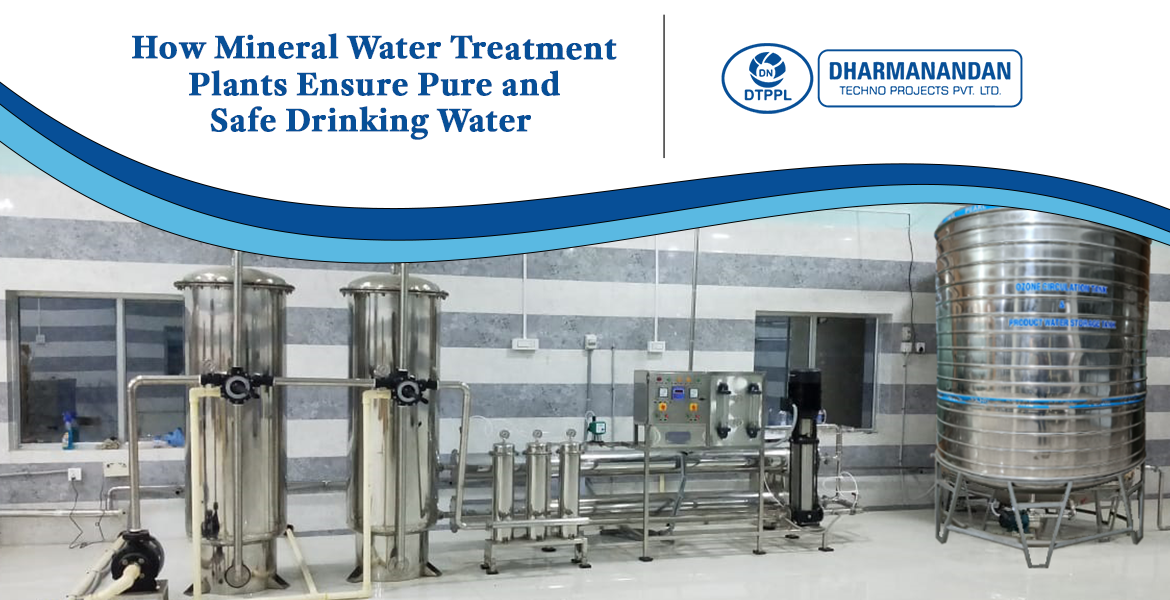
Table of Contents
How mineral water treatment plant ensure pure and safe drinking water?
May 23, 2024
In the pursuit of health and well-being, mineral water treatment plant emerges as the most essential element, especially when it is pure, safe, and mineral-rich. This is where the best mineral water in India play a vital role, employing advanced technologies and rigorous processes to convert raw water into safe, mineral-enriched drinking water.Importance of Pure and Safe Drinking Water
Water, often hailed as the ‘elixir of life’, is essential for the survival and well-being of all living beings, including humans. The importance of clean and safe drinking water cannot be overstated for several reasons:
Health and Cleanliness: Contaminated water can harbor harmful bacteria, viruses, and parasites, leading to diseases like cholera, dysentery, and typhoid. Consuming clean and secure water helps prevent these diseases, promoting overall health and cleanliness.
Nutrition: Clean water is free from harmful chemicals and impurities but retains essential minerals such as calcium, magnesium, and potassium, which are beneficial for our health. These minerals contribute to our daily nutritional needs.
Digestion: Drinking clean water aids in digestion by helping break down food and absorb nutrients more effectively, ensuring our bodies receive the nourishment they need.
Detoxification: Water plays a crucial role in flushing out toxins from our bodies. By drinking clean and safe water, we can ensure the efficient removal of waste and toxins, leading to healthier skin and a well-functioning body.
Sustainability: Utilizing facilities that specialize in water purification reduces the reliance on bottled water, which often leads to plastic waste. This step is vital for environmental sustainability.
Clean and secure drinking water is not just a basic human need but also a critical component of our overall health and well-being. Ensuring access to clean and safe drinking water for everyone, everywhere is essential.
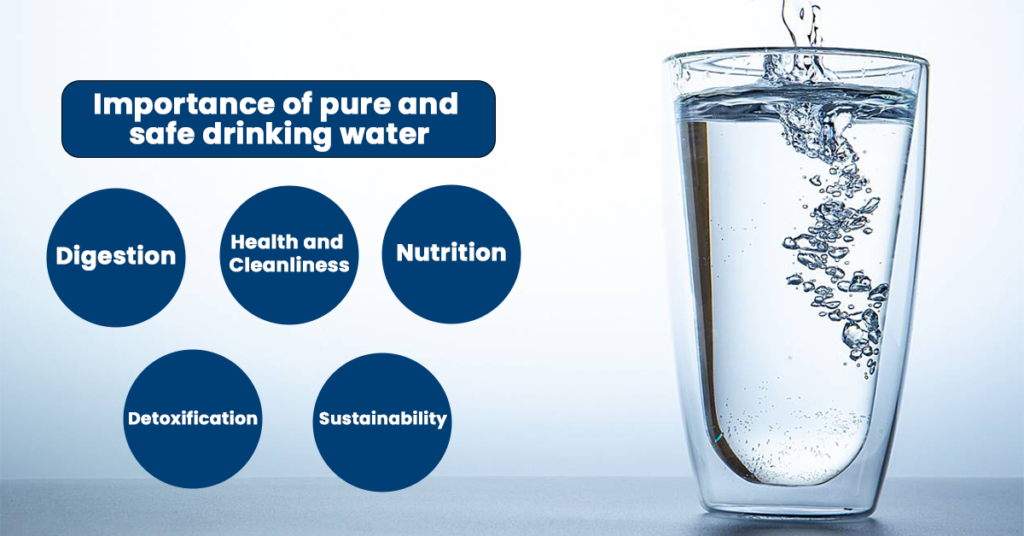
Implement the Mineral Water Treatment Process
To ensure the production of safe, high-quality drinking water, it is essential to implement a comprehensive and scientifically proven water treatment process. This begins with the collection and settling of raw water to eliminate larger particles and impurities. Chlorination is then used to disinfect the water, followed by multi-stage filtration using sand, activated carbon, and micron filters to remove suspended solids, odors, and finer contaminants. Depending on the source quality, Reverse Osmosis (RO) may be used to eliminate dissolved salts and impurities. Advanced disinfection methods like UV treatment and ozonation are employed to eliminate any remaining pathogens and ensure microbiological safety. In the final stage, mineralization is carried out to reintroduce essential minerals such as magnesium and potassium, improving both the taste and health benefits of the water. This robust process ensures the final product meets stringent safety standards and consumer expectations.
Source Water Collection & Screening: The First Line of Safety
When we talk about mineral water treatment, it’s easy to focus on the fancy purification steps-but it all starts upstream. Collecting water from rivers, lakes, reservoirs, or groundwater requires carefully designed intake systems. These include screens or mesh grates that trap large debris-think leaves, twigs, even small aquatic life-before it enters pumps or pipes. This screening prevents damage to downstream equipment and lays the foundation for a smooth, effective purification process. By ensuring only pre-screened water moves forward, treatment plants reduce clogging in filters and avoid mechanical breakdowns-saving on maintenance and ensuring a safer product from the start.
Coagulation and Flocculation: Aggregating the Invisible
Small particles in raw water-like clay, silt, or organic matter-often hang in suspension and are undetectable to the naked eye. That’s where coagulation steps in: a coagulant (often aluminum or iron salts) is dosed into the water to neutralize charges on those tiny particles. Then, flocculation-a gentle mixing-encourages these destabilized bits to collide and cluster, forming larger, heavier “flocs.” These clumps make it easier to remove impurities in the next stage. Some modern plants even use natural polymers like chitosan, which are biodegradable and bind efficiently with heavy metals-offering eco-friendly alternatives to traditional chemicals.
Sedimentation: Let Gravity Do the Work
Once flocs form, the water flows into a sedimentation basin, also known as a clarification tank. Here, gravity gradually settles the heavier particles to the bottom, separating them from the clearer water above. Designs may include large rectangular or circular tanks, sometimes enhanced with inclined plates or lamella clarifiers to boost efficiency in a smaller footprint. Settling times typically range from 1.5 to 4 hours. The collected sludge must then be removed and treated-a critical step that keeps the entire system running smoothly and avoids recontamination.
Filtration Methods
Facilities specializing in the purification and enrichment of mineral water treatment plant utilize a range of filtration techniques to ensure the cleanliness and safety of drinking water. These techniques not only eliminate impurities but also help maintain the essential minerals in the water. Let’s delve into these filtration methods:
Reverse Osmosis (RO): This is a procedure where water is compelled through a semipermeable membrane under high pressure. The membrane permits water molecules to pass through while obstructing larger molecules, such as salts, bacteria, and other impurities. RO is highly effective in eliminating contaminants and producing clean water.
Activated Carbon Filtration: Activated carbon filters function by adsorption, a chemical reaction where certain particles are attracted to activated carbon and bond with it. This method is effective in removing organic compounds, chlorine, and other chemicals that affect the taste and odor of water.
UV Treatment: Ultraviolet (UV) light can kill or inactivate harmful microorganisms, rendering the water safe to drink. It’s an effective method for disinfecting water without using chemicals.
Microfiltration and Ultrafiltration: These are pressure-driven processes that remove particulate matter from water using a porous membrane. Microfiltration is effective in removing particles in the range of 0.1 to 10 micrometers, while ultrafiltration can remove particles as small as 0.01 micrometers. These methods are often used to remove bacteria, viruses, and other microorganisms from water.
Multi-media Filtration: This involves passing water through several layers of filter media, each designed to remove a specific type of contaminant. The media layers may include sand, anthracite, and garnet, among others. This method is effective in removing suspended solids and reducing turbidity in water.
By employing these filtration methods, facilities specializing in the purification and enrichment of water ensure that the water we drink is not only clean but also safe and healthy. These technologies play a crucial role in providing access to clean and safe water for everyone, everywhere.
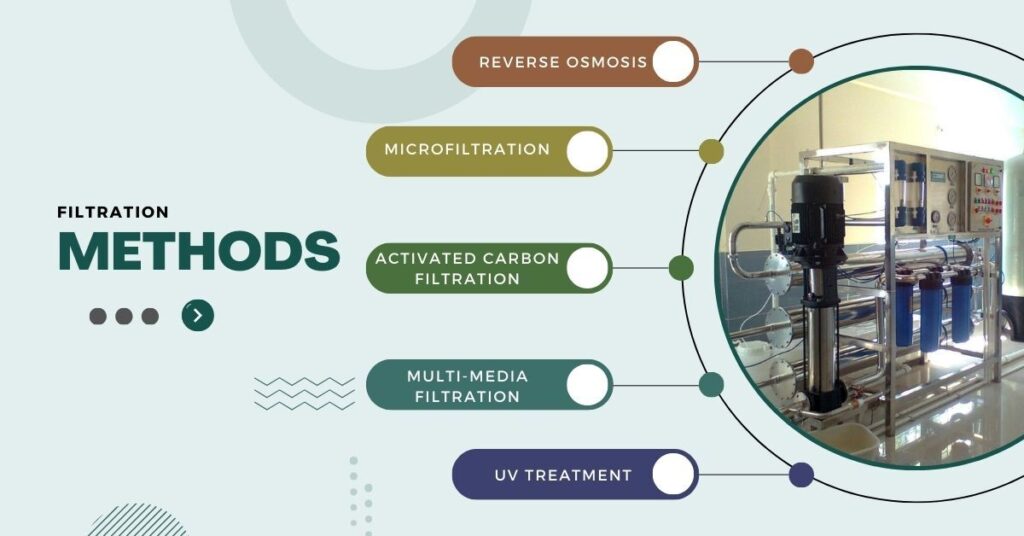
Dissolved Air Flotation: Floating Out Fine Particles
In situations where raw water has high color, algal blooms, or very fine suspended contaminants, sedimentation can struggle. Enter Dissolved Air Flotation (DAF)-an alternative that injects micro‑bubbles into water under pressure. These bubbles cling to tiny particles and lift them to the surface, forming a frothy layer that can be skimmed off. It’s especially useful when particles resist settling or source water is highly turbid. DAF offers a compact footprint-a big plus when space is limited-and adds a valuable tool for tougher raw water challenges.
Balancing Mineral Content in Drinking Water
Facilities specializing in the purification and enrichment of mineral water treatment plant plays a pivotal role not just in cleansing water, but also in maintaining its mineral equilibrium. This balance holds significance for several reasons:
Regulatory Standards: There exist specific regulatory benchmarks set by health organizations globally that prescribe the minimum and maximum levels of certain minerals in drinking water. These standards ensure that the water is safe for consumption and provides necessary nutrients.
Health Benefits: Minerals like calcium, magnesium, and potassium in water contribute to our daily nutritional needs. They play vital roles in various bodily functions, including bone health, heart health, and maintaining electrolyte balance.
Taste and Palatability: The mineral content in water can significantly affect its taste. For instance, water with high calcium and magnesium levels tends to have a “hard” taste, while water with low mineral content, often termed “soft water,” may taste bland or slightly salty.
Consumer Expectations: Consumers often have specific expectations about the taste and quality of their drinking water. Maintaining mineral equilibrium is key to meeting these expectations and ensuring consumer satisfaction.
Quality Control: Regular monitoring and adjustment of mineral content in water are part of the quality control process in water treatment facilities. This ensures consistent quality of the water supplied to consumers.
Maintaining mineral equilibrium in water is a critical aspect of water treatment. It not only ensures the safety and health benefits of the water but also enhances its taste and meets consumer expectations. Thus, facilities specializing in the purification and enrichment of water play a vital role in providing high-quality water that is not just pure and safe, but also nutritionally beneficial and palatable.
Ion Exchange and Lime Softening: Controlling Hardness and TDS
If source water has high mineral content (like calcium or magnesium), ion exchange can soften water by swapping these hardness ions for sodium-a common method in household softeners and industrial plants alike. Alternatively, lime softening raises pH to precipitate hardness minerals physically, which can then be filtered out-a lower‑cost solution for large volumes.
Reverse Osmosis & Nanofiltration go even further, using semi‑permeable membranes to reject dissolved salts, nitrates, and other small molecules. Nanofiltration strikes a balance-it removes undesirable micro‑pollutants but retains essential minerals for taste. Reverse Osmosis, on the other hand, provides highly purified water (low TDS), ideal for certain premium mineral products-but it also creates reject water that needs proper handling. These tools give plants fine control over taste, safety, and mineral balance.
Quality Testing Procedures For Mineral Water Treatment Plant
Maintaining the quality of drinking water is a top priority for the best mineral water plant in India. These facilities employ a series of rigorous testing procedures to ensure the water is safe for consumption. Here’s an overview of these procedures:
Contaminant Detection: This involves testing the water for a variety of contaminants, including heavy metals, pesticides, and other harmful substances. Advanced detection techniques are used to identify and quantify these contaminants to ensure they are within safe limits.
Microbiological Analysis: This test is conducted to detect the presence of harmful microorganisms in the water. It helps ensure that the water is free from bacteria, viruses, and other pathogens that can cause diseases.
Chemical Analysis: This involves testing the water for its chemical composition. It includes checking the levels of essential minerals and ensuring harmful chemicals are below the permissible limits.
pH and Turbidity Testing: The pH level of water indicates its acidity or alkalinity, while turbidity measures the clarity of water. Both these factors are important for the taste and safety of drinking water.
Compliance Verification: This involves checking whether the water meets all the regulatory standards set by health organizations. It ensures that the water produced by the facility is safe for consumption.
Traceability and Documentation: All the testing procedures and their results are thoroughly documented. This ensures traceability and helps in quality control and continuous improvement.
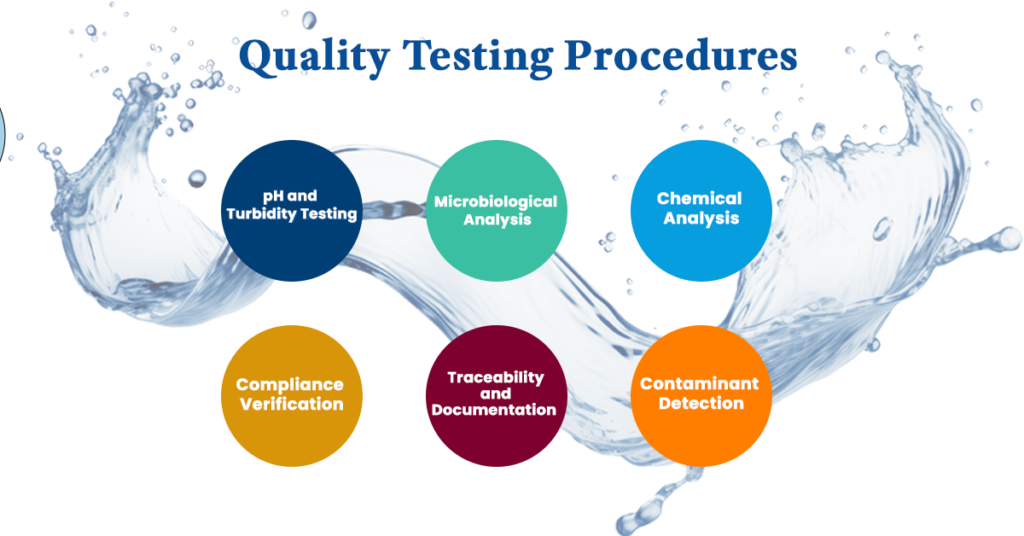
UV Disinfection in Mineral Water Treatment Plant
UV disinfection is a critical process in top mineral water treatment plant operations that ensures the safety of drinking water. Let’s delve into how it works and its importance in the water plant business:
How does UV Disinfection work in a mineral water plant?: UV light damages the DNA of harmful microorganisms, rendering them unable to reproduce and effectively killing them. It’s a physical process that doesn’t alter the water chemically, making it a crucial part of the mineral water business.
Effectiveness Against Pathogens: UV disinfection is highly effective against a wide range of pathogens, including bacteria, viruses, and protozoa. It’s particularly useful against chlorine-resistant pathogens like Cryptosporidium and Giardia.
Chemical-Free Treatment: One of the major advantages of UV disinfection in the water business is that it doesn’t involve the use of chemicals. This means it doesn’t leave any residual substances in the water, making it a safe and environmentally friendly treatment method.
Complementary Process: While UV disinfection is highly effective, it’s often used in conjunction with other treatment processes in a mineral water plant. This ensures a comprehensive treatment that addresses a wide range of potential water quality issues.
Monitoring and Maintenance: UV disinfection systems in mineral water plants require regular monitoring and maintenance to ensure their effectiveness. This includes checking the intensity of the UV light and cleaning the UV lamps to prevent any decrease in light transmission due to fouling.
Regulatory Compliance: UV disinfection systems in mineral water plant projects are designed to meet regulatory standards for drinking water quality. They play a crucial role in ensuring that the water supplied to consumers is not only pure but also safe to drink.
Packaging and Distribution of Mineral Water
Once the water has been treated and is safe for consumption, the next steps are **packaging** and **distribution**. These are crucial stages in the journey of drinking water from water purification facilities to the consumer.
Packaging: The packaging process involves filling the treated water into bottles or other containers. This process is typically automated to ensure hygiene and efficiency. The packaging material is carefully chosen to prevent any contamination of the water. It’s also designed to be sturdy and convenient for the consumers.
Quality Check: Before the packaged water leaves the water processing facility, it undergoes a final quality check. This includes checking the seal of the containers, the clarity of the water, and the accuracy of the labels.
Distribution: The packaged mineral water is then distributed to various sales points, including supermarkets, convenience stores, and vending machines. The distribution process is designed to ensure that the water reaches the consumers in the best condition, without any compromise on its quality.
Storage: Proper storage is crucial to maintain the quality of the mineral water. It should be stored in a cool and dry place, away from direct sunlight and chemicals. This helps preserve the taste and quality of the water until it reaches the consumer.
Consumer Use: Finally, the packaged mineral water is ready for consumption. Consumers can trust the quality and safety of the water, thanks to the rigorous processes followed by the water purification facilities.
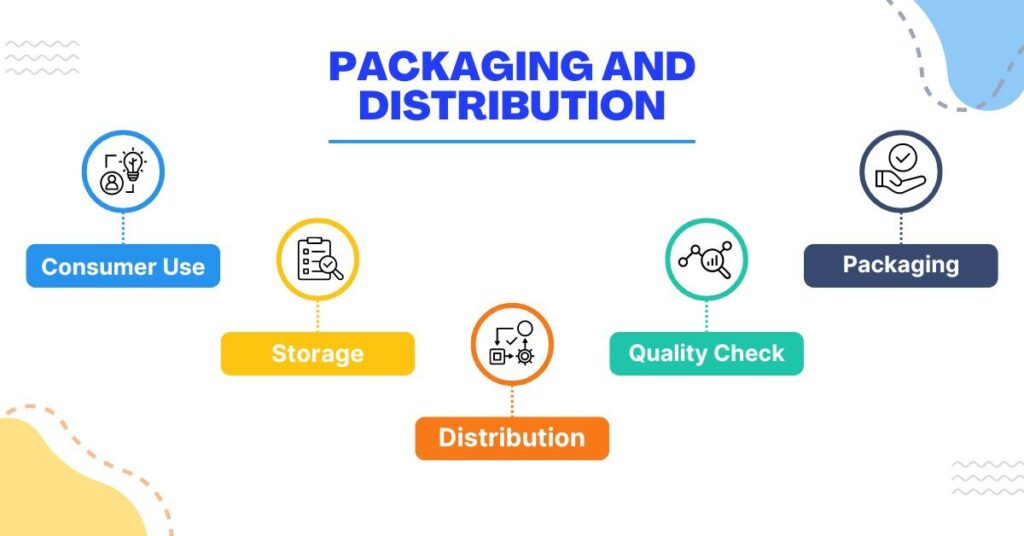
Environmental Considerations
Water purification facilities play a crucial role in providing safe and pure drinking water, a key aspect of the water supply industry. However, it’s equally important that these facilities operate in an environmentally responsible manner. Here are some key environmental considerations:
Water Source Protection: The source of water used by the water processing facility should be sustainably managed to prevent over-extraction. Protecting the water source also involves preventing pollution and maintaining the health of the surrounding ecosystem.
Energy Efficiency: The processes used in water purification facilities, such as filtration and disinfection, can be energy-intensive. Therefore, it’s important to implement energy-efficient technologies and practices to minimize the environmental footprint.
Waste Management: The treatment process in the water supply industry generates waste, including spent filters and sludge. Proper waste management practices should be in place to ensure that this waste is disposed of in an environmentally friendly manner.
Packaging: The packaging used for mineral water in the water supply industry should be recyclable or biodegradable to reduce plastic waste. Many companies are now moving towards more sustainable packaging options, such as glass bottles or plant-based plastics.
Distribution: The distribution of bottled water in the water supply industry should be done in a way that minimizes carbon emissions. This could involve optimizing delivery routes or using vehicles that run on clean energy.
Regulatory Compliance: Water purification facilities should comply with all relevant environmental regulations. This includes regulations related to water extraction, waste disposal, and emissions.
These considerations ensure that the water supply industry not only provides safe and pure drinking water but also contributes positively to the environment. This is a testament to the commitment of these facilities to operate responsibly while providing high-quality mineral water to everyone, everywhere.
The Multi‑Barrier Approach: Ensuring Safety from Source to Tap
A core philosophy in drinking water safety is the multi‑barrier approach-protecting water at multiple stages rather than relying on just one step. That means:
- Safeguarding the source (e.g., preventing upstream pollution)
- Building redundancy into treatment (multiple clarification or disinfection steps)
- Securing distribution (maintaining disinfectant residuals)
- Conducting proactive monitoring (source, plant, tap)
- Having emergency plans ready (like boil‑water advisories if contamination is detected).
This layered defense ensures that even if one step falters, others stand by-keeping consumers safe and confident in every glass.
Challenges Facing Mineral Water Treatment Plants
Modern plants must navigate rising demands, aging infrastructure, and emerging threats like microplastics, pharmaceuticals, or changing water chemistry. Climate shifts can reduce source supply or increase raw water variability, making consistent quality harder to maintain.
Innovations Powering the Future
Thankfully, innovation is rising to meet these challenges:
- Advanced membranes (nanocomposite, biomimetic) boost filtration while lowering energy use.
- Graphene filters offer ultra‑efficient contaminant removal, though still pricey.
- Modular, portable systems can be deployed quickly in remote or emergency situations.
- IoT and smart sensors enable real‑time tracking of water quality, flow rates, and system health-letting teams act before issues escalate.
- AI and machine learning help predict contaminant spikes and guide optimal dosing and maintenance schedules.
- Solar‑powered filtration systems bring clean water to off‑grid communities with minimal carbon footprint.
Together, these advances promise safer, greener, and more resilient mineral water operations for tomorrow.
Conclusion
While mineral water treatment plants play a vital role in providing safe drinking water, they must also operate in a way that minimizes their impact on the environment. This ensures that we can enjoy pure and safe mineral water today without compromising the ability of future generations to do the same.
In conclusion, mineral water treatment plant are pivotal in ensuring the availability of pure and safe drinking water. From the initial filtration methods to the final packaging and distribution, every step is meticulously designed and executed to ensure the highest quality of water.
About Author

Director – Global Marketing and Sales
Mr. Bhavesh from Dharmanandan Techno Projects Pvt. Ltd. has played a pivotal role in elevating the DTPPL brand to the global stage, leveraging his exceptional expertise in marketing and communications. He is committed to helping clients achieve significant growth while strengthening their own brands. Dharmanandan Techno Projects Pvt. Ltd. is a leading manufacturer and supplier of water purification systems and turnkey solutions for mineral water plants. With years of experience in designing and delivering high-quality water treatment solutions, the company provides end-to-end services, including system design, installation, maintenance, and ongoing support. Specializing in scalable and customizable water plants, DTPPL has successfully served industries worldwide, ensuring clean and safe drinking water across diverse applications.




